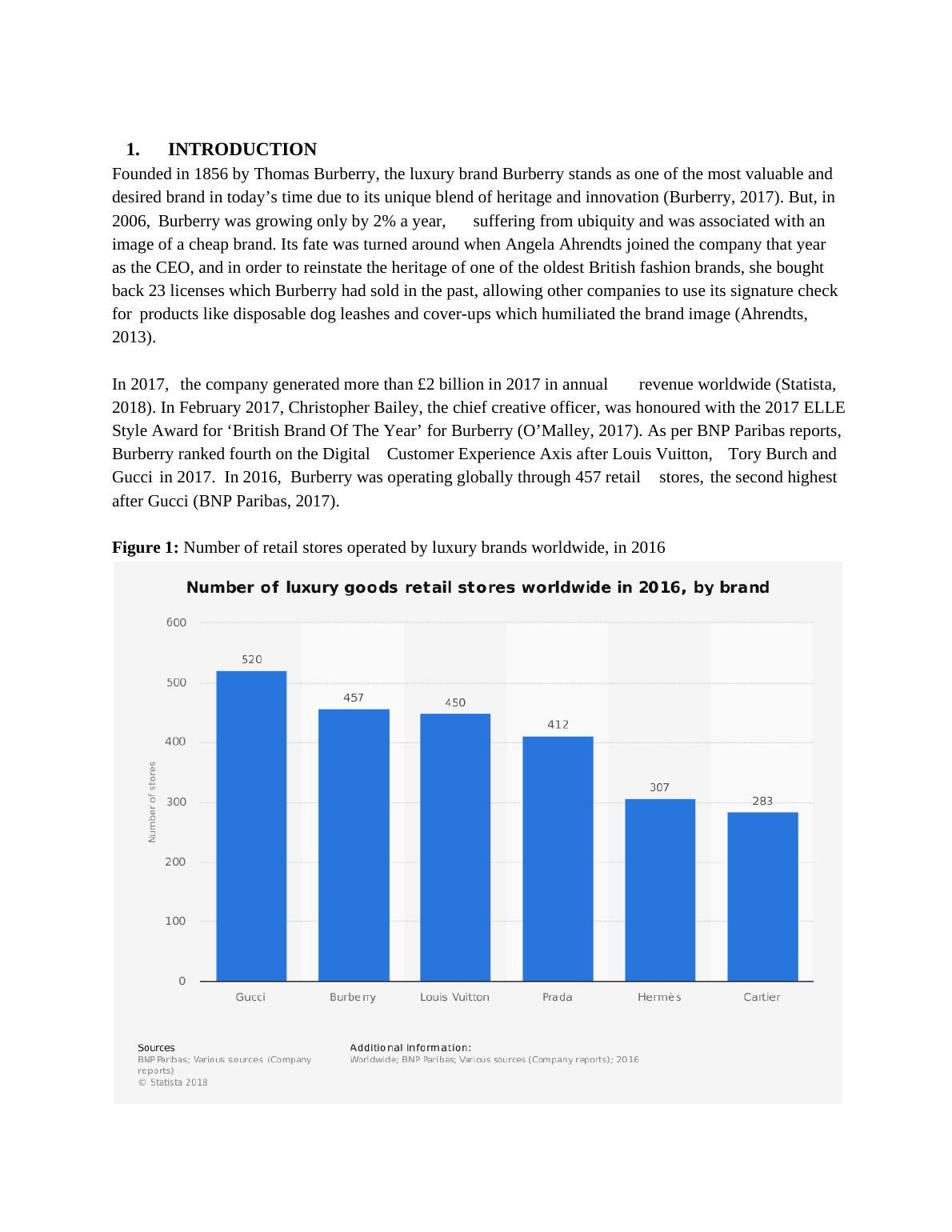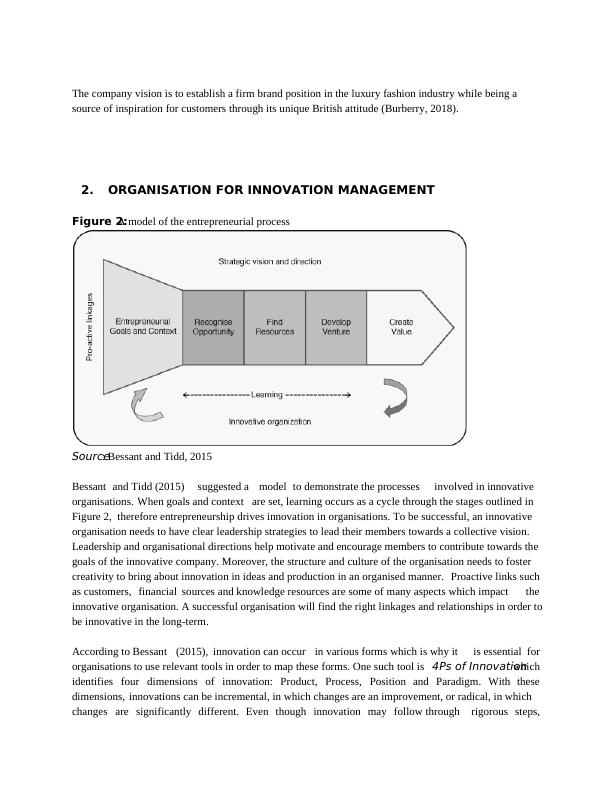(PDF) Business Analysis - Burberry
Added on 2021-06-08
14 Pages4298 Words70 Views
EXECUTIVE SUMMARYTABLE OF CONTENTS1.INTRODUCTION.....................................................................2.ORGANISATION ARCHITECTURE...................2.1.ORGANISATION STRUCTURE...........................................2.2.ORGANISATION CULTURE...............................................2.3.LEADERSHIP.................................................................3.STRATEGY FOR INNOVATION MANAGEMENT...........................3.1.CORPORATE STRATEGY..................................................3.2.DIGITAL INNOVATION AND CUSTOMER ENGAGEMENT......3.3.OPEN INNOVATION.........................................................4.RECOMMENDATIONS.............................................................5.CONCLUSION.........................................................................6.REFERENCES.........................................................................7.APPENDICES.........................................................................7.1.APPENDIX I..................................................................7.2.APPENDIX II.................................................................

1.INTRODUCTIONFounded in 1856 by Thomas Burberry, the luxury brand Burberry stands as one of the most valuable anddesired brand in today’s time due to its unique blend of heritage and innovation (Burberry, 2017). But, in2006,Burberry was growing only by 2% a year,suffering from ubiquity and was associated with animage of a cheap brand. Its fate was turned around when Angela Ahrendts joined the company that yearas the CEO, and in order to reinstate the heritage of one of the oldest British fashion brands, she boughtback 23 licenses which Burberry had sold in the past, allowing other companies to use its signature checkforproducts like disposable dog leashes and cover-ups which humiliated the brand image (Ahrendts,2013).In 2017,the company generated more than £2 billion in 2017 in annualrevenue worldwide (Statista,2018). In February 2017, Christopher Bailey, the chief creative officer, was honoured with the 2017 ELLEStyle Award for ‘British Brand Of The Year’ for Burberry (O’Malley, 2017). As per BNP Paribas reports,Burberry ranked fourth on the DigitalCustomer Experience Axis after Louis Vuitton,Tory Burch andGucciin 2017.In 2016,Burberry was operating globally through 457 retailstores,the second highestafter Gucci (BNP Paribas, 2017).Figure 1:Number of retail stores operated by luxury brands worldwide, in 2016

The company vision is to establish a firm brand position in the luxury fashion industry while being asource of inspiration for customers through its unique British attitude (Burberry, 2018).2.ORGANISATION FOR INNOVATION MANAGEMENTFigure 2:A model of the entrepreneurial processSource: Bessant and Tidd, 2015Bessantand Tidd (2015)suggested amodelto demonstrate the processesinvolved in innovativeorganisations.When goals and contextare set, learning occurs as a cycle through the stages outlined inFigure 2,therefore entrepreneurship drives innovation in organisations. To be successful, an innovativeorganisation needs to have clear leadership strategies to lead their members towards a collective vision.Leadership and organisational directions help motivate and encourage members to contribute towards thegoals of the innovative company. Moreover, the structure and culture of the organisation needs to fostercreativity to bring about innovation in ideas and production in an organised manner.Proactive links suchas customers,financialsources and knowledge resources are some of many aspects which impacttheinnovative organisation. A successful organisation will find the right linkages and relationships in order tobe innovative in the long-term.According to Bessant(2015),innovation can occurin various forms which is why itis essentialfororganisations to use relevant tools in order to map these forms. One such tool is4Ps of Innovationwhichidentifiesfourdimensionsofinnovation:Product,Process,PositionandParadigm.Withthesedimensions,innovations can be incremental, in which changes are an improvement, or radical, in whichchangesaresignificantlydifferent.Eventhoughinnovationmayfollow throughrigoroussteps,

unexpected changes can happen, thus organisations need to build dynamic capability, where organisationshave the ability to adapt their innovation management in evolving environments.2.1.ORGANISATION STRUCTUREFigure 3:Burberry’s Board Committee and their respective rolesSource: Burberry, 2018Burberry’s Board Committee is made up of 10 members, such as the Chairman, Chief Creative Officer,Chief Executive Officer, Chief Operating and Financial Officer, and Senior Independent Director, who isinchargeofthenon-executivedirectors.Theboardmemberswork collaboratively towardstheeffectiveness,governanceand performanceofmanagementin theorganisation.Communication isessential and effectively managed between the Board and key shareholders, so that actions discussed areagreed upon and implemented with approval.The Senior IndependentDirector is another contactforshareholders while overseeing performance and strategy delivery with regards to potential risks identifiedby the Board. The Chief Creative and Chief Executive Officer are responsible for the sustainable strategicvision and direction ofthe company while collaborating with the SeniorIndependentDirector.Onoccasions,Burberry willask forexternalconsultantsand professionalsto advise during committeemeetings and aid in implementation of strategies when necessary.TheBoard isresponsibleforthelong-term successin strategy and implementation ofplansforinnovation,governance,financialresources and expenditure,and risk management.This reflects theproactivelinkages,thatthe board playsa partin to ensure the organisation maintainscontinuousinnovation through financial sources, strategy visions and implementation of knowledge gathered.Burberry’s business process is broken down into four parts, “design”, “develop”, “make” and “distribute& sell” (see appendix 3). Throughout Burberry’s organisational structure, it can be seen that creativity is

End of preview
Want to access all the pages? Upload your documents or become a member.
Related Documents
Marketing Essentialslg...
|16
|1175
|42
Importance of Innovation and Commercializationlg...
|16
|5096
|92
Repositioning of Burberry Brand: A Case Studylg...
|6
|1401
|296
Importance of Innovation and Commercialisation: Doclg...
|18
|4792
|21
Essentials of Marketing Functionlg...
|15
|4540
|486
Relevance and Importance of Positioning and Repositioning for Marketerslg...
|8
|1652
|329
